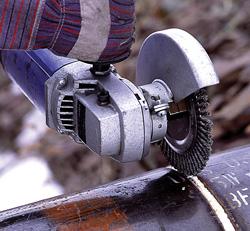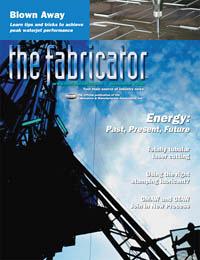- FMA
- The Fabricator
- FABTECH
- Canadian Metalworking
Categories
- Additive Manufacturing
- Aluminum Welding
- Arc Welding
- Assembly and Joining
- Automation and Robotics
- Bending and Forming
- Consumables
- Cutting and Weld Prep
- Electric Vehicles
- En Español
- Finishing
- Hydroforming
- Laser Cutting
- Laser Welding
- Machining
- Manufacturing Software
- Materials Handling
- Metals/Materials
- Oxyfuel Cutting
- Plasma Cutting
- Power Tools
- Punching and Other Holemaking
- Roll Forming
- Safety
- Sawing
- Shearing
- Shop Management
- Testing and Measuring
- Tube and Pipe Fabrication
- Tube and Pipe Production
- Waterjet Cutting
Industry Directory
Webcasts
Podcasts
FAB 40
Advertise
Subscribe
Account Login
Search
5 tips for better finishing with steel brushes
Getting more performance and life for improved results
- By Ron Vogt Sr.
- November 7, 2006
- Article
- Finishing

Steel wire brushes can be used for weld cleaning, deburring, rust and oxide removal, surface preparation, and surface finishing.
Steel wire brushes are a common and essential tool in any metal fabrication shop. These brushes can be used for a variety of applications, including weld cleaning, deburring, rust and oxide removal, surface preparation, and surface finishing.
One reason wire brushes are so widely used is that, unlike solid abrasive wheels, steel filaments will not remove base material or change part dimensions. Wire brushes clean surfaces in the same manner as sandblasting, except that rather than particles of sand colliding with the work surface, wire tips make contact with the workpiece. The combination of good-quality, hardened steel wire tips with the energy of high surface speeds enables the brushes to separate surface contaminants from base material.
Steel brushes also are versatile, with many different configurations available to meet the requirements of each application. For example, brushes with long filaments are conformable and able to follow contoured surfaces, and short trim brushes are fast-acting and suited for severe applications. Another variable is the fill density: Low-density brushes offer good flexibility for surface cleaning operations on irregular surfaces, and high-density brushes produce a fast brushing action and long brush life.
In addition, steel brushes are nonloading. In other words, they do not become clogged with particles and debris when used to remove paint and similar coatings.
Perhaps because wire brushes are such a familiar item, they are easy to overlook and often receive insufficient attention. However, five tips can help you improve the performance and life span of your wire brushes.
1. Use the Highest Safe Speed
Power wire brushes, like cutting tools, operate most effectively when the speed and pressure of the operation properly match the demands of the application. In most operations, using the highest speed with the lightest possible pressure will ensure the fastest brushing action and longest brush life.
Increasing brush speed to the highest safe speed increases the face stiffness and brushing action. A fine-wire brush rotating at a high speed often produces the same results as a coarse-wire brush rotating at a slow speed, but it generally lasts longer. Therefore, you will achieve the lowest production costs by using the finest wire that will do the job.
If the brush speed is insufficient, frustrated operators typically apply more pressure (see Figure 1). However, excessive pressure causes overbending of the filaments and heat buildup, resulting in filament breakage, rapid dulling, and reduced brush life.
Instead of applying greater pressure, try using a brush with more aggressive action, such as one with a larger filament diameter and/or a shorter filament trim length, or one with a knot type instead of crimped wire. Or you can try increasing brush surface speed by increasing rotations per minute (RPM) or brush diameter.
You'll need to determine the correct operating speed for each application. For safety, it is imperative never to exceed the maximum safe free speed (MSFS) or RPM rating that the manufacturer publishes for each type of brush.

Figure 1Excessive pressure causes over bending of the filaments, resulting in filament breakage, rapid dulling, and reduced brush life.
2. Periodically Reverse Direction
To increase the performance and extend the life of wire wheel brushes without nuts, such as the brushes commonly used on a bench grinder, here is a quick and easy tip: Periodically reverse the direction of rotation to take advantage of the self-sharpening action that will result (see Figure 2).
To reverse the direction of rotation, simply remove the brush from the spindle, flip the wire brush 180 degrees, and remount the brush securely.
3. Know Which Type of Wire to Use
Crimped-wire brushes are general-purpose brushes that can be used for a range of applications. They are made of hard-drawn wire that is crimped to allow individual filaments to support each other. Crimped-wire brushes provide flexibility for light- to medium-duty brushing action, and they should be used on parts that could be damaged by the impact of a knot brush.
Knot-wire brushes (see Figure 3) are made of heat-treated straight wire filaments twisted as a single unit resembling a piece of cable or wire rope. They provide less flexibility and more aggressive brushing action than crimped brushes in heavy-duty applications on parts that require high-impact action. Knot-wire brushes frequently are used in welding applications and to remove large burrs and heavy contamination, such as multiple layers of rust, scale, paint, or oxides.
4. Keep Stainless Steel Brushes Clean
Stainless steel brushes often are used on stainless steel and aluminum and other nonferrous metals to eliminate the danger of "after-rust" appearing on the work surface. By following a few simple practices, you can maximize the effectiveness of these tools.
Once you use a stainless steel brush on carbon steel, do not use it on stainless steel because after-rust can occur. To prevent contamination, store all stainless brushes away from areas where carbon steel particles might come in contact with the brushes, such as steel workbenches.
Contrary to a popular misconception, a stainless steel brush wire is magnetic. As a result, the time-tested practice of using a magnet to check whether steel is stainless or carbon does not work on brushes. The drawing process, which is used to produce brush wire, causes the material to be attracted to a magnet. The effects of the drawing process can be eliminated by heating the wire with a match until it becomes red-hot. If the wire is Type 302 stainless, it will not be attracted to a magnet after heating.
For critical operations, degrease stainless steel wire brushes before beginning the operation. If you'll be storing the brushes after use, degrease them and wrap them in plastic. If you store the brushes without protection for any length of time, their magnetic properties may cause the brushes to collect foreign matter, leaving after-rust when reused.
5. Use Heat-treated, Oil-tempered Steel Wire
Although stainless steel has the advantage of eliminating after-rust, carbon steel is superior in the critical attributes of cutting action and fatigue resistance. When purchasing carbon steel brushes for industrial applications, it is important to buy ones that contain filaments made from high-quality material. Look for heat-treated, oil-tempered or heat-treated, high-tensile steel, especially in wire diameters of 0.008 inch and greater.
You can purchase cheaper brushes from the neighborhood hardware store or do-it-yourself retailer, but in the long run, you might end up spending more because of reduced productivity, more changeover time, and brush replacement costs. For example, a $5 brush might last an hour, whereas a $10 brush will probably last more than a day.
About the Author
Related Companies
subscribe now

The Fabricator is North America's leading magazine for the metal forming and fabricating industry. The magazine delivers the news, technical articles, and case histories that enable fabricators to do their jobs more efficiently. The Fabricator has served the industry since 1970.
start your free subscription- Stay connected from anywhere

Easily access valuable industry resources now with full access to the digital edition of The Fabricator.

Easily access valuable industry resources now with full access to the digital edition of The Welder.

Easily access valuable industry resources now with full access to the digital edition of The Tube and Pipe Journal.
- Podcasting
- Podcast:
- The Fabricator Podcast
- Published:
- 04/16/2024
- Running Time:
- 63:29
In this episode of The Fabricator Podcast, Caleb Chamberlain, co-founder and CEO of OSH Cut, discusses his company’s...
- Trending Articles
AI, machine learning, and the future of metal fabrication

Employee ownership: The best way to ensure engagement

Dynamic Metal blossoms with each passing year

Steel industry reacts to Nucor’s new weekly published HRC price

Metal fabrication management: A guide for new supervisors

- Industry Events
16th Annual Safety Conference
- April 30 - May 1, 2024
- Elgin,
Pipe and Tube Conference
- May 21 - 22, 2024
- Omaha, NE
World-Class Roll Forming Workshop
- June 5 - 6, 2024
- Louisville, KY
Advanced Laser Application Workshop
- June 25 - 27, 2024
- Novi, MI



























